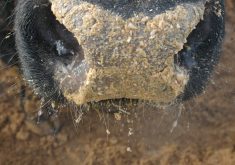Glacier FarmMedia – Canadian consumers are largely fine with pork from gene-edited pigs — at least once the science and benefits are explained to them.
That’s according to new research from genetic development company PIC (Pig Improvement Company), which is using gene editing technology to develop a pig resistant to porcine reproductive and respiratory syndrome (PRRS).
A survey found that, after consumers read a description of gene editing in food and the PRRS-resistant pig, 49 per cent indicated positive or very positive sentiments, 38 per cent were neutral while 14 per cent were negative or very negative.
Read Also

Alberta irrigation project on grasslands approved
Environmental concerns raised by Alberta conservation groups over irrigation expansion project within rural municipality
“Even though we’ve seen a lot of investments in things like vaccines and improved biosecurity, the problem is getting worse, not better,” said Banks Baker, PIC’s global director of product sustainability.
North America’s pork producers have been dealing with PRRS since the late 1980s. The viral disease causes respiratory issues in all ages of pigs. In breeding animals, though, it can derail reproductive performance.
A veterinary manual from Merk Animal Health said stillbirths and mummies can increase between 25 to 35 per cent, abortions jump and anorexia and agalactia in the mother can increase piglet deaths by 30 to 50 per cent. If they do survive, they don’t perform as well post-weaning.
A 2024 study by University of Guelph researcher Lynn Marchand estimated the annual cost of PRRS to a benchmark Manitoban 1,200-sow farrow-to-finish farm could be $588,709 to $631,602.
In January 2024, Ontario saw more severe cases of PRRS than it had in two years, veterinarian Dr. Ryan Tenbergen recently told attendees at the South Western Ontario Pork Conference. New strains of the disease, infecting more easily and severely, were also popping up in the United States.
The industry argues that genetically modified organisms have garnered a reputation for being unsafe and unhealthy, despite scientific evidence to the contrary. Further, they argue, gene editing is different.
Genetic modification typically refers to adding genetic information from an outside source, whereas gene editing generally involves making small changes to the organism’s existing genome.
“GMO has had a long shadow,” said Marisa Pooley, PIC’s director of communications.
“We have used it as a case study to make sure that we’re putting the consumer at the centre of this.”
Consumers identified reducing animal illness and antibiotic use reduction as factors that would motivate them to purchase gene-edited pork.
They seemed to like the idea that gene editing could help farmers raise healthier animals more sustainably and to grow crops better able to withstand climate change. The idea that gene editing can be used to cure human diseases such as sickle cell anemia and cancer also improved feelings.
Budget is the top driver of food purchases, PIC’s research confirmed, with 70 per cent of respondents ranking cost first. However, 73 per cent said they’d prefer to buy meat that’s antibiotic-free, 69 per cent preferred meat with animal welfare claims and 65 per cent gravitated toward environmental claims. About half said they’d pay more for meat raised in the way they prefer.
PIC says on its website that the PRRS-resistant pig will be available in the United States by 2026 “at the earliest.”
“(However), given the global nature of pork industry and trade and import and export, we are not going to commercialize in the United States until we also have approvals from Canada, Mexico and Japan, at a minimum,” said Baker.
Canada’s regulations have, so far, focused on plants. In recent years, Health Canada ruled that gene-edited plants would not be considered novel foods —a designation requiring more stringent safety checks —if the plant doesn’t contain foreign DNA and the plant’s key nutritional composition remained unchanged. It later approved gene-edited crops for livestock feed.
“In Canada and other countries, we are working with regulatory agencies to show that the PRRS-resistant pigs and resulting pork products are no different than any other pigs and pork, except for their resistance to the PRRS virus,” said Pooley.
They hope to receive Canadian approvals in 2025.


















